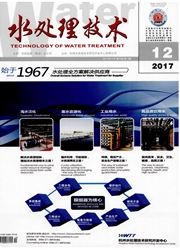

 中文摘要:
中文摘要:
采用絮凝-超滤组合工艺对工业印染废水的二级生化出水进行深度处理,探讨了絮凝、超滤及絮凝-超滤联用对废水中COD和浊度等去除的效果,从膜通量和膜阻力的角度分析了絮凝对减轻膜污染的作用。结果表明,超滤具有较好的除浊功能,去除率高达92%,COD去除率仅43%。PAC投加量为50mg·L^-1时,单独絮凝对浊度去除率可达60.5%,但对COD去除率低于20%。絮凝-超滤联用不仅能提高产水水质,使浊度和COD去除率分别达到99.8%和54%,而且对提高产水通量和减轻膜污染效果显著。通过阻力计算表明,直接超滤的阻力主要为可恢复阻力,不同压力下Rr/Rir值均在0.7以上,絮凝+冲洗可大幅减小膜阻力,因而更适于工业化应用。
 英文摘要:
英文摘要:
Ultrafiltration (UF) with coagulation was used to treat the secondary effluent from textile plant. The retention of turbidity and COD were compared in three cases including UF, coagulation and coagulation-ultrafiltration treatment. Results showed that although UF possessed a considerable retention rate of turbidity up to 92%, the COD removal was as low as 43%. At 50 mg·L^-1,dosage of PAC, single coagulation treatment had a turbidity retention as high as 60.5%, while its COD retention was always lower than 20%. Treatment coupling ultrafiltration with coagaltion not only improved water quality, in which the retention rate of turbidity and COD was up to 99.8% and 54% respectively, but also effectively enhanced membrane flux and alleviate membrane fouling. The membrane resistances by calculation revealed that total membrane resistance was mainly composed by the recoverable resistance in single ultrafiltration treatment whose Rr/Rir value was always higher than 0.7 under different pressure. Ultrafiltration treatment coupled with coagulation and backflush can reduce membrane resistance to a great extent and therefore was more suitable for industrial application.
 同期刊论文项目
同期刊论文项目
 同项目期刊论文
同项目期刊论文
 Physicochemical characteristics of hollow fiber structured packings in isopropanol/water distillatio
Physicochemical characteristics of hollow fiber structured packings in isopropanol/water distillatio 期刊信息
期刊信息
